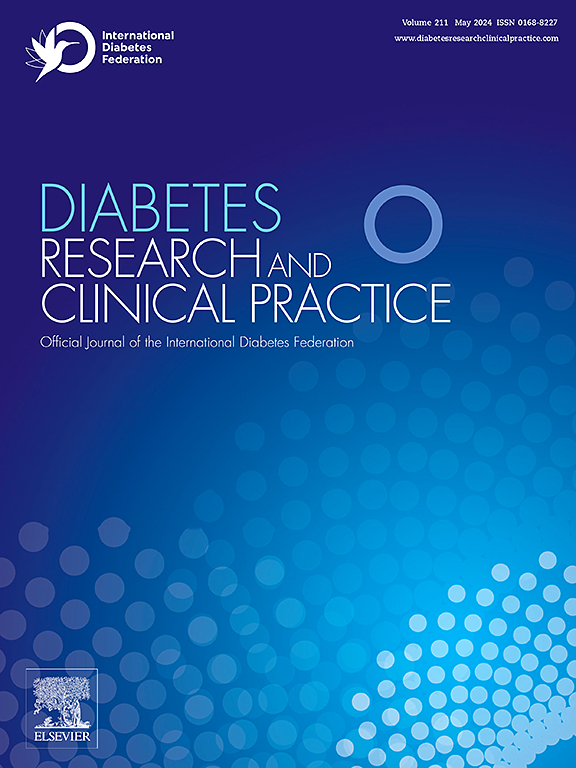2型糖尿病和PNPLA3的次要等位基因一致地确定了与脂肪变性肝病相关的高危代谢功能障碍。
IF 6.1
3区 医学
Q1 ENDOCRINOLOGY & METABOLISM
引用次数: 0
摘要
背景:遗传因素与MASLD的无创检测(NITs)之间的关系尚未得到很好的证实。方法:临床和实验室数据,肝活检和/或肝刚度测量(LSM)通过瞬时弹性成像收集从三级护理肝病实践中看到的MASLD患者。评估基因组位点rs641738 (MBOAT7)、rss58542926 (TM6SF2)、rs738409 (PNPLA3)、rs62305723 (HSD1713B)的次要等位基因频率与高ELF(≥11.3)、高FIB-4(≥3.25)、高LSM(≥10 kPa)、组织学纤维化(3/4期vs 0-2期)的相关性。结果:在2289个患者MASLD可用的多态性和肝纤维化/ NIT数据(52 ± 13年,46 %男,BMI 36.6±9.9 ,35 % 2型糖尿病(T2D)], 53 %有高风险的等位基因(C > G)在rs738409 (PNPLA3), 70 %高风险等位基因(C > T)在rs641738 (MBOAT7), 18 %高风险小等位基因(C > T)在rs58542926 (TM6SF2), 11 %低风险较小的等位基因(G > A)在rs62305723 (HSD17b13)。只有PNPLA3-rs738409(47 % CC, 40 % CG, 13 % GG)与较高的NIT评分和组织学纤维化显著相关:高ELF 2.8 % CC vs. 8.1 % CG/GG;高FIB-4 4.7 % CC vs. 11.6 % CG/GG;高LSM 10 % vs. 19 %;结论:PNPLA3基因rs738409多态性、T2D和年龄是高危MASLD的独立预测因子。本文章由计算机程序翻译,如有差异,请以英文原文为准。
Type 2 diabetes and the minor allele of PNPLA3 consistently identify high-risk metabolic dysfunction associated steatotic liver disease
Background
Association of genetic factors with non-invasive tests (NITs) for MASLD has not been well established.
Methods
Clinical and laboratory data, liver biopsy and/or liver stiffness measurement (LSM) by transient elastography were collected from MASLD patients seen in tertiary care hepatology practices. Minor allele frequency for genomic loci rs641738 (MBOAT7), rs58542926 (TM6SF2), rs738409 (PNPLA3), rs62305723 (HSD1713B) were evaluated for association with high ELF (≥11.3), high FIB-4 (≥3.25), high LSM (≥10 kPa), histologic fibrosis (stage 3/4 vs. stages 0–2).
Results
Among 2289 MASLD patients with available polymorphism and liver fibrosis/NIT data [52 ± 13 years, 46 % male, BMI 36.6 ± 9.9, 35 % type 2 diabetes (T2D)], 53 % had high-risk allele (C > G) at rs738409 (PNPLA3), 70 % high-risk allele (C > T) at rs641738 (MBOAT7), 18 % high-risk minor allele (C > T) at rs58542926 (TM6SF2), 11 % low-risk minor allele (G > A) at rs62305723 (HSD17b13). Only PNPLA3-rs738409 (47 % CC, 40 % CG, 13 % GG) was significantly associated with higher NIT scores and histologic fibrosis: high ELF 2.8 % CC vs. 8.1 % CG/GG; high FIB-4 4.7 % CC vs. 11.6 % CG/GG; high LSM 10 % vs. 19 %; advanced histologic fibrosis 34 % CC vs. 60 % CG/GG (all p < 0.01). Similar associations of PNPLA3-rs738409 with NITs were observed in a subgroup of MASLD patients with T2D (n = 799; all p < 0.05). The PNPLA3-rs738409 CG/GG genotype, older age and T2D were independently associated with high ELF [OR (95 % CI) = 3.25 (2.03–5.20)], FIB-4 [OR = 2.75 (1.90–3.98)], LSM [OR = 2.71 (1.60–4.59)] scores and advanced histologic fibrosis [OR = 2.56 (1.81–3.62)].
Conclusions
The polymorphism rs738409 in the PNPLA3 gene, T2D, and older age were independent predictors of high-risk MASLD.
求助全文
通过发布文献求助,成功后即可免费获取论文全文。
去求助
来源期刊

Diabetes research and clinical practice
医学-内分泌学与代谢
CiteScore
10.30
自引率
3.90%
发文量
862
审稿时长
32 days
期刊介绍:
Diabetes Research and Clinical Practice is an international journal for health-care providers and clinically oriented researchers that publishes high-quality original research articles and expert reviews in diabetes and related areas. The role of the journal is to provide a venue for dissemination of knowledge and discussion of topics related to diabetes clinical research and patient care. Topics of focus include translational science, genetics, immunology, nutrition, psychosocial research, epidemiology, prevention, socio-economic research, complications, new treatments, technologies and therapy.
 求助内容:
求助内容: 应助结果提醒方式:
应助结果提醒方式:


